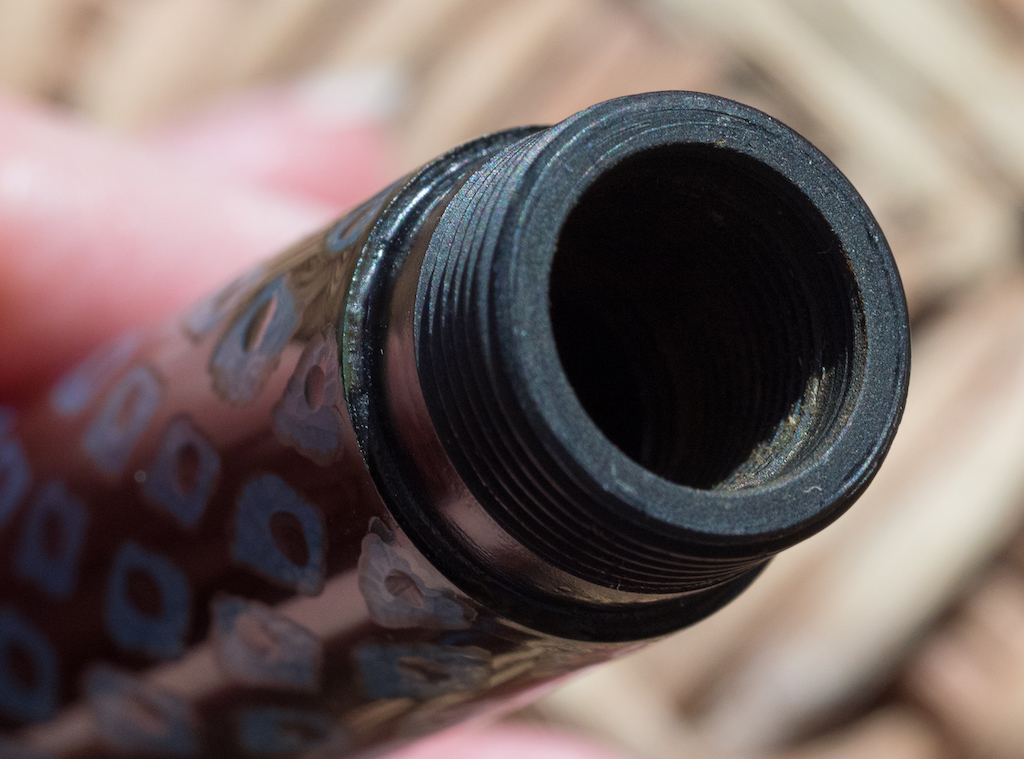(Susan M. Pigott is a fountain pen collector, pen and paperholic, photographer, and professor. You can find more from Susan on her blog Scribalishess.)
Every once in a while, you run across a pen that is so unique and so absurdly beautiful that you’ll do whatever it takes to own it. For me, that pen is the Danitrio Kama-nuri Kamakura-bori Blue Tame-nuri on Takumi (what a mouthful!) I honestly did not intend to buy another Danitrio. I owned a Sho-Hakkaku (reviewed here) that I eventually sold because I didn’t use it that often, and I found the soft stub to be too wide for my writing style (though I loved the feel of the nib). I told myself that if I found a Kama-nuri in blue, I would buy it.
Sure enough, Bryant, at Chatterley Luxuries let me know he got some Kama-nuris in, so I went to the site and looked. My finger was poised to click on the blue Kama-nuri when I saw a pen that dazzled me. I’d never seen anything like it before. Not only was it Kama-nuri style, it was more than that--blue diamonds were carved all over the body of the pen with carved black dots in the middle of each diamond. It was more expensive than any pen I’ve ever bought (I’ll just say it was close to $2000), and I told myself, “Absolutely not.” But then I thought, “What’s the chance that you’ll ever see a pen like this again?” So I bought it, and subsequently I sold a bunch of beloved pens to cover the cost. Was it worth it? You’ll have to read the rest of the review to find out.
Considering how expensive Danitrios are, the packaging is a bit of a disappointment. My pen came in a softwood box lined in fake red velvet. Unlike Nakaya, you don’t get a kimono for your pen, and although I never use my kimonos anyway, they are a nice touch. I found no paperwork or information about the artist included in the box.
My Kamakura-bori began life as a black Urushi Takumi model. Then, the artist (Mr. Kazushi Kanego) applied layers of blue Urushi over the black. This was followed by more layers of black Urushi. Next, the artist hand-chiseled the diamond (or rhombus) pattern into the blue layer. Last he chiseled dots down into the original black layer. You can see the individual chisel marks in the macro photo below. Plus, you can see how thick the Urushi is in the second photo.
The result is a pen that is both beautiful to the eye but also tactile: you can feel the patterns with your fingers. Plus, this is no machine-made pen. The patterns are imperfect because they are done by hand. This makes the pen all the more beautiful, and it is absolutely unique.
The Takumi model is a cartridge/converter style pen, which suits me just fine. I’ve tried Danitrio’s eye-droppers and found them messy and unreliable in terms of flow (I may have just had bad luck). Sure, an eye-dropper holds more ink, but the converter is easy to use.
My pen has a gold-plated clip that is easy to manipulate. I prefer Danitrio’s painted clips, but obviously that wasn’t a deal-breaker for me.
The Takumi is a large pen, measuring 145mm/5.71 inches capped and 130mm/5.11 inches uncapped (Danitrios aren’t meant to be posted). Because it is made of Urushi, the pen is by no means heavy. It is comfortable in the hand (even though it is 16mm in diameter), and I experience no fatigue writing with it.
The #6 size, two-tone, 18k gold fine nib is perfectly proportioned for the pen. It has Danitrio’s distinctive fire logo on it. Unlike Japanese nibs, Danitrio fines are really closer to a western fine or a Japanese medium.
Unfortunately, my nib has issues. I noticed from the beginning that the nib was a bit scratchy and that it didn’t seem to write a consistently wet line. It’s been so rainy in Abilene that I had to wait quite a while for a day with enough sunlight to take macro photos of the nib. I discovered that the tines are misaligned, so that explains the problems I’m having.
I filled my pen with Sailor Yama-Dori, which is a terrific color to match the blue on the pen. When the pen is freshly inked, the nib alignment is not as noticeable, and the writing looks pretty good. But after the first few sentences, the misalignment becomes noticeable and the ink no longer flows as smoothly onto the paper. Obviously, this is a major disappointment in a pen this expensive.
So, is it worth it? Well . . . yes and no. Obviously, a pen’s worth is completely subjective. Some readers might think this pen is rather ostentatious. Others might agree with me that it is amazingly beautiful and unique. But ultimately, what matters is what I think, since I’m the one who spent the big bucks to buy it. Considering the amount of time the artist spent crafting this pen, and considering how unique the pen is, I purchased more than just a writing instrument. I purchased a piece of art that no one else on earth possesses. True, Mr. Kanego may have created other pieces with the same design, but since he hand-carved them, each pen is unique.
That said, I am disappointed with the nib. While it writes adequately, the misaligned tines definitely detract from the quality of the writing experience. I will have to send it in to get the tines realigned and the nib adjusted for better flow.
Only a few pen dealers offer Danitrios, and Chatterley Luxuries currently has the largest inventory. If you’re interested in a Kama-nuri model (all of which are hand carved), I suggest you head over to Chatterley Luxuries soon.
(I purchased this Danitrio pen with my own funds (and sold a ton of pens to pay for it!))



































